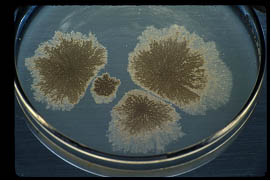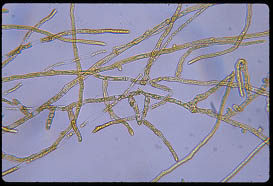Biology of Pythium

The genus Pythium comprises about eighty-five species. Pythium species are common pathogens causing disease in plants and fishes. The species of this genus are among the most destructive plant pathogens, inflicting serious economic losses of crops by destroying seed, storage organs, roots, and other plant tissues. Pythium insidiosum is the
The genus Pythium comprises about eighty-five species. Pythium species are common pathogens causing disease in plants and fishes. The species of this genus are among the most destructive plant pathogens, inflicting serious economic losses of crops by destroying seed, storage organs, roots, and other plant tissues. Pythium insidiosum is the only species reported to cause infections in mammals. The disease caused by this unique microorganism has been termed pythiosis (insidiosi) and can cause life threatening infections in cats, dogs, cattle, equines, captive polar bears, and humans.
Members of the genus Pythium have been described as “aquatic fungi”. However, they are not true fungi (Kingdom Fungi), they belong to the Kingdom Stramenopila, Phylum Oomycota, Class Oomycetes, Family Pythiaceae. In culture, P. insidiosum develops sparsely septate fungal-like hyphae similar to those produced by the Zygomycetes (true fungi). Like other Oomycetes, P. insidiosum produces motile zoospores (asexual stage) when exposed to damp conditions. The zoospores are single cells with two lateral flagella that swim to find a new plant host where it completes its lifecycle. Once in contact with the host the zoospores lose their flagella and encyst. It is believed that zoospores act as infecting units once in contact with a mammalian host (J. Mycol. Med. 6:151; 1996). Under conditions, still under investigation, P. insidiosum develops globose oogonia (sexual stage) typical of this species, but they are rarely observed in most isolates.
only species reported to cause infections in mammals. The disease caused by this unique microorganism has been termed pythiosis (insidiosi) and can cause life threatening infections in cats, dogs, cattle, equines, captive polar bears, and humans.
Members of the genus Pythium have been described as “aquatic fungi”. However, they are not true fungi (Kingdom Fungi), they belong to the Kingdom Stramenopila, Phylum Oomycota, Class Oomycetes, Family Pythiaceae. In culture, P. insidiosum develops sparsely septate fungal-like hyphae similar to those produced by the Zygomycetes (true fungi). Like other Oomycetes, P. insidiosum produces motile zoospores (asexual stage) when exposed to damp conditions. The zoospores are single cells with two lateral flagella that swim to find a new plant host where it completes its lifecycle. Once in contact with the host the zoospores lose their flagella and encyst. It is believed that zoospores act as infecting units once in contact with a mammalian host (J. Mycol. Med. 6:151; 1996). Under conditions, still under investigation, P. insidiosum develops globose oogonia (sexual stage) typical of this species, but they are rarely observed in most isolates.
Like other oomycetes, P. insidiosum grows relatively well on a variety of media. On corn meal agar and Sabouraud dextrose, colonies are color less to white, submerged with short aerial mycelium and a finely radiate pattern. The coenocytic hyphae range between 4 and 12 mm in diameter with 90o perpendicular lateral branches. Septation is only occasionally observed in early hyphae, but they

become abundant in old viable hyphae. Hyphal swellings, that mimic sporangia measuring 12 to 28 in diameter, are common in laboratory cultures.
Production of zoospores can be induced in water cultures containing minimal quantities of different ions and grass leaves at 37o C. Zoospore induction in water without ions is rare. Early sporangia can not be differentiated from normal hyphae. These early sporangia, at maturity, flows their cytoplasm into a discharge tube and form a globose sporangium. The cytoplasmic content of the sporangium goes through progressive cleavage and biflagellated zoospores are formed inside a vesicle. The zoospores mechanically break the sporangium vesicle wall and swim approximately 20-30 minutes and then encyst. It is believe that P. insidiosum use a plant to complete its life cycle in nature (lily or grass), but it has not been confirmed.




